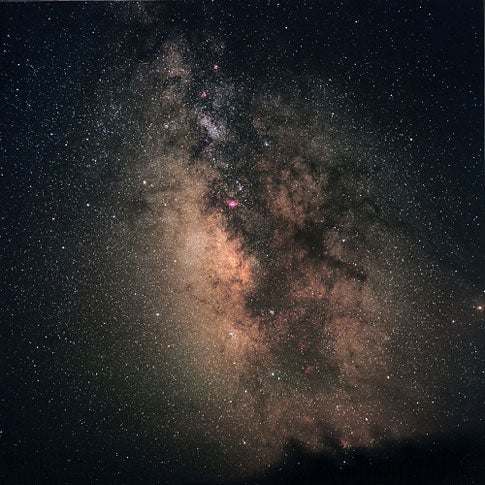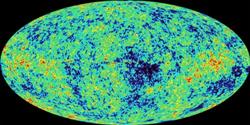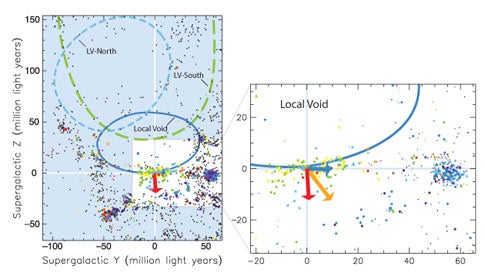Our Milky Way galaxy lies at the edge of a huge void and is being repulsed by the void at high speed. This observation provides astronomers with fundamental insights into how dark matter is distributed and the process of galaxy formation. Brent Tully of the University of Hawaii discussed this discovery at the meeting of the American Astronomical Society in Honolulu, Hawaii.
Two decades ago, Tully and his collaborator, Richard Fisher (National Radio Astronomy Observatory, Charlottesville, Virginia), noted that our galaxy lives adjacent a vast empty region that they called the ‘Local Void.’ Today, thanks to the contributions of many astronomers around the world, there is information on the distribution of hundreds of thousands of galaxies and an increasingly detailed knowledge of the rich tapestry in the distribution of galaxies. Galaxies collect along filaments and in clusters, at places where the filaments intersect. Elsewhere there are empty regions called voids. Our galaxy resides in a filament that bounds a void. We call this filament the ‘Local Sheet.’
It has also been known for two decades that our Milky Way galaxy is traveling through intergalactic space at high speed. The Cosmic Microwave Background (CMB) is radiation that comes to us in all directions from the time when the universe was a hot plasma, 300,000 years after the Big Bang. One part in a hundred systematic variations in frequency of the peak of the CMB radiation is taken to be a Doppler shift caused by our motion with respect to the ensemble of all other matter. Some of the components of our motion have been known for a long time. Earth orbits the Sun once a year and the Sun orbits the center of the Milky Way Galaxy every 250 million years. We also have known that our galaxy is being pulled toward neighboring concentrations of matter, particularly our nearest giant neighbor, the Andromeda Galaxy, at a distance of 2-million light-years and the nearest rich cluster of thousands of galaxies, the Virgo Cluster, at 55 million light-years. It has also become clear that there are very long-range forces pulling on us. We have a motion in a direction toward two huge concentrations of galaxies that happen by chance to line up, one behind the other, at distances of 200 and 600 million light-years. The relative importance of these two attractors has remained a disputed detail among astronomers.
Now, another kind of observation has resolved the mystery. Astronomers have been measuring the distances to galaxies with precision techniques. With accurate distances it is possible to distinguish between the motions of galaxies due to the general expansion of the universe and the local deviant motions caused by the way matter is clumped, with its consequent gravitational effects. It is found that galaxies are flowing in streams, with coherent flows caused by large attractors far away and eddies caused by modest attractors nearby. The influences on our motion discussed above have been confirmed. In addition, features of the local streaming pattern reveal the source of the additional component.
The critical new information comes from observations of relatively nearby galaxies with Hubble Space Telescope. Accurate distances to galaxies are provided by measuring the luminosities of the brightest old stars that lie on what is known as the Red Giant Branch. These stars have well-established properties. The accurate distances give a detailed map of the flow pattern of nearby galaxies and reveal several remarkable things. First, the direction of our motion with respect to the nearest several thousand galaxies is well defined. Second, all the galaxies within 15 million light-years, within our Local Sheet, are moving together. Third, this motion is NOT shared by galaxies just beyond our Local Sheet and, in fact, we are moving on a collision course toward the nearest adjacent filament, the Leo Spur (it will be at least 10 billion years before the Local Sheet and the Leo Spur pancake together).
To generate such a large velocity, the void must be very large and very empty. The current standard model of the universe with dark matter and dark energy does allow for voids that are as large as we infer for the Local Void, but it is impressive that we should live next to such a large feature. More importantly for our theoretical understanding, we conclude that the void is really empty. Only a small fraction of the matter of the universe is in a visible form, so it is not a given that an apparently empty region is truly empty. However, the large push we are getting from the Local Void is convincing evidence that it really is empty.












